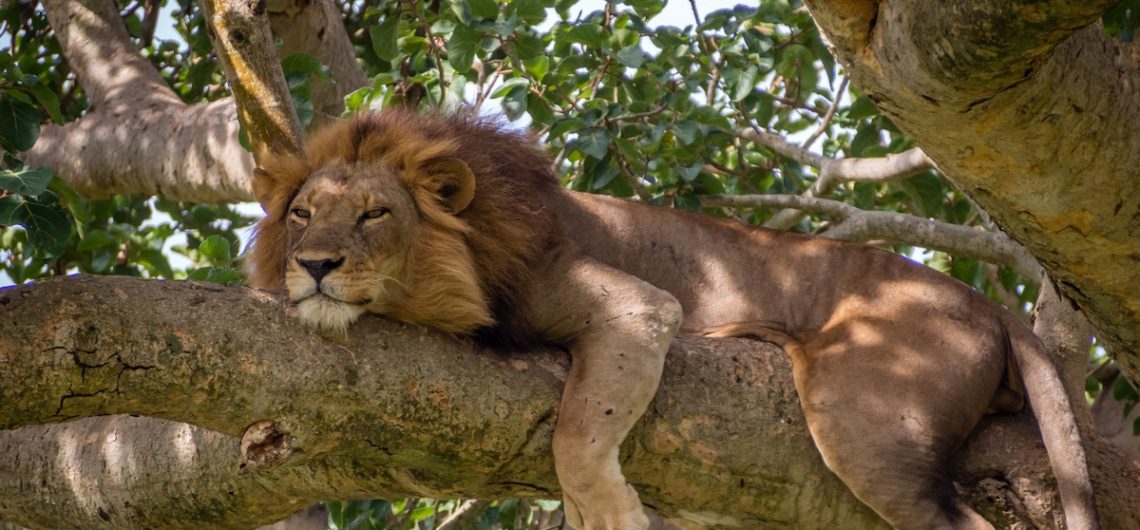
This is Uganda’s most visited as well as popular wildlife habitat best known for its tree climbing lions, a large number of African Wildlife as well as thrilling Kazinga Boat Cruise which can all be enjoyed during your Private Safari in Uganda. Queen Elizabeth National Park (QENP) among the attractions that tourists visit while on Uganda safaris, this park together with the Kigezi and Kyambura Wildlife Reserves form one of the most diversified eco-systems on the African continent.
Wildlife Habitats in Queen Elizabeth National Park
Lakes: The water from the melting glaciers on Mt. Rwenzori form a large network of wetlands and two big lakes – Lakes George and Edward, as well as the attractive Kazinga Channel that connects these two beautiful lakes. The lakes’ shores are crowded by large schools of hippos which can easily be seen on your Uganda Safari here.
Savannah: Its Open savannah area that is scattered with Euphorbia plus Acacia trees offers habitat to topi, numerous buffaloes, giant forest hogs, Uganda Kobs, hyenas, elephants, waterbucks, leopards as well as lions.
Woodland: There are Ten (10) primate species among which are chimpanzees within the park. The park prides in a bird-list of more than 550 species and it the best bird watching destination in Uganda.
What to Do in Queen Elizabeth Park, Safari Activities
Wildlife Watching / Game Drives
Game drives in the park are conducted both in the early mornings as well as in the late afternoons on a daily basis along the different tracks found inside the park. With over 200km of tracks a number of the, going through the Uganda Kob’s mating grounds, you will have an opportunity to see a variety of animals such as lions (with a population of the unique tree climbing lions living in the southern part of the park), giant elephants buffaloes, forest hogs, warthogs, different antelope species as well as bushbucks. All our game drives are unrushed to offer you enough time to take photographs, and are led by our very knowledgeable and experienced safari guides you detail you about the flora and fauna in this park. Please feel free to ask then any questions you want.
Chimpanzees Tracking in Kyambura Gorge
Chimpanzee tracking is another greatly loved activity within this park and it is conducted in the forested Kyambura gorge. Science says that chimpanzees are the closest living cousins to man. So this activity will offer you an opportunity to search through the forest gorge for these amazing apes. You will come face to face with the chimps, observe them, take pictures and even record videos. Within the gorge you are likely to encounter other primates live the olive baboons, red tailed monkeys, colobus monkesy plus a variety of birds.
The Kazinga Channel Boat Trip
The Kazinga Channel is a natural water-channel that connects lakes George and Edward. Its shores are normally swarming with different wildlife such as crocodiles, the largest group of hippos in the country, some elephants, and a large profusion of different birds including several migrant species. The boat ride normally takes 2 hours.
Visit the Tree Climbing Lions in Ishasha Area
Ishasha area is found within the southern part of the park and its terrain is dotted with giant fig and acacia trees in which these lions are normally seen resting. Generally lions do not climb trees however the lions in this area do so. The area which was named after River Ishasha that flows through has a variety of herbivores like the Uganda Kobs, buffaloes, Topis plus different types of monkeys on which these lions prey.
Bird Watching in Queen Elizabeth National Park
Queen Elizabeth National Park is one of Uganda’s best bird watching destinations. Thanks to the great diversity of habitats within, the park has over 600 bird species recorded there. These can be seen during our exciting Uganda Birding Safaris, and a keen bird-watcher can see close to 200 birds in one day. Our birding guides are well experienced and knowledgeable so they will lead you to the best places to see birds.
Among the birds you will see in QENP include: the Shoebill Stork – Uganda’s most sought after bird, Lesser flamingos, African fish eagle, African Mourning dove, martial eagle, Red-capped lark, Black headed Gonek, Pin tailed Whydah, African skimmer, papyrus gonolek, Grey headed Kingfisher and the Slender tailed Nightjars. For a better rewarding bird watching experience, we recommend that you dedicated at least two days to this.
Explore the Bats Cave, and Nature Walks
Within the Maramagambo forest you will have an opportunity to do a nature walk during which you will see different plant species, butterflies, birds as well as monkeys. You will also visit the Bat caves which offer habitat to several birds that feed on the pythons that live inside this park.
A visit to the Traditional Salt Works
You can also choose to visit the traditional salt works on Lake Katwe. Mining of salt in this area started back in the 14th Century, and the people have been using tradition mining methods ever since then to date. During the dry months, they collect the largest quantity of salt.
Best time to Visit Queen Elizabeth National Park
Queen Elizabeth National Park can be visited all year round, however we recommend that you avoid the wet months (April and May, and September to November) as the tracks are normally slippery.
How to Get There
The park can access either by road or air transport.
By Road: For those driving from Kampala, you can reach the park using the Masaka – Mbarara highway, or through Fort Portal. Or you can connect to the park from Kabale.
By Air: There are three different airfields located near the park and these are found in: those Ishasha, Mweya Peninsula and Kasese.
Where to Stay, Accommodation in Queen Elizabeth National Park
Fortunately, there are several different types of accommodation within and around the park in which you can stay on your Uganda Safari and these range from the luxury facilities, mid-range facilities and budget facilities. These include: Mweya hostel, Jacana safari lodge, Mweya safari lodge and Ishasha wilderness camp among so many others
Traveler’s tips while in Queen Elizabeth National Park:
The Do’s
Pay the Park entrance fee at the park gate
Spend the night only in designated areas
Always give the animals a right-of-way
The Don’ts
Don’t move out of your car unless in designated areas
Don’t drive at a speed beyond 45km per hour while in the park
Never sound your horn
Don’t litter
Don’t throw cigarette-ends in the park –they may start a fire
Don’t carry your pet animals inside the park
Don’t pick or cut any type of plants in the park
Don’t carry ammunition or firearms inside the park
